Physical Address
304 North Cardinal St.
Dorchester Center, MA 02124
Physical Address
304 North Cardinal St.
Dorchester Center, MA 02124
The Elegoo Mars Pro outclasses this original Mars model in many ways as it has several impressive performance and design enhancements that ultimately improve upon the overall great experience of its predecessor.
One of the notable performance enhancements is a fresher BGW15CA linear guide for the Z-axis which significantly improves the print accuracy. The other one is the improved light source (50W instead of the Mars 40W) which provides a faster curing speed. The Mars Pro also offers better light uniformity and a new build plate which has an upgraded 0.15mm CD pattern surface that provides better adhesiveness as well as easier print removal.
As for the design upgrades, Elegoo has moved the USB port to the front on the Mars Pro instead of the back like it was in the original Mars model. It has also included new features like a built-in carbon filter and a silicone rubber seal/gasket that’s put on the base of the UV cover to minimize resin odor leakage. The resin vat is equally larger than that of the Mars model.
Generally, the Mars Pro offers considerable improvements that make it a more competent printer than its predecessor. It’s far more accurate and easier to use. The print quality and level of detail were absolutely amazing – we printed at least 30 miniatures and we had very few fails. Here’s an in-depth look at what you can expect from it including a few setbacks that it has.
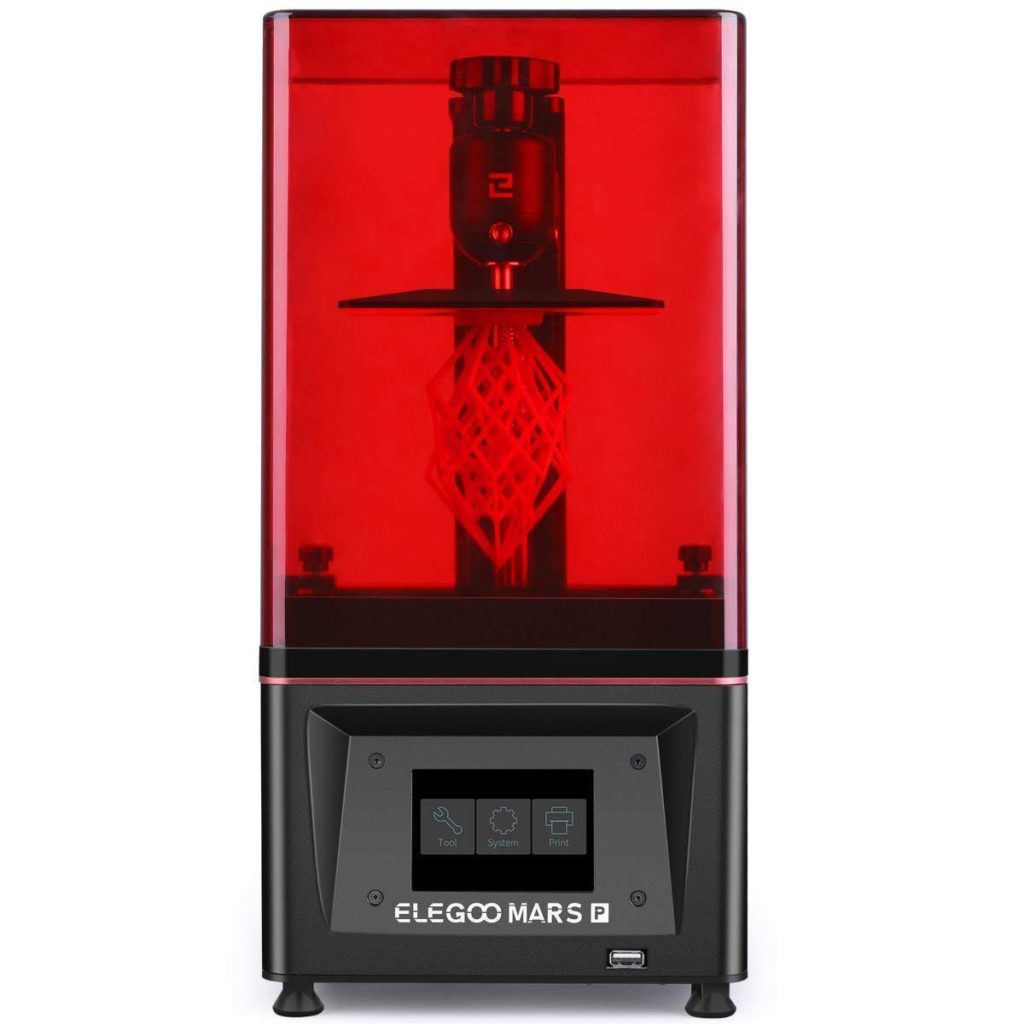
The Mars Pro is a resin (LCD/MSLA) 3D printer produced by Elegoo, a China-based 3D printer manufacturer that has been developing and producing resin 3D printers since 2017. It’s an upgrade of the company’s flagship model, the Elegoo Mars which was arguably amongst the best entry-level resin 3D printers on the market, competing with the likes of Phrozen3D, Anycubic, and many others.
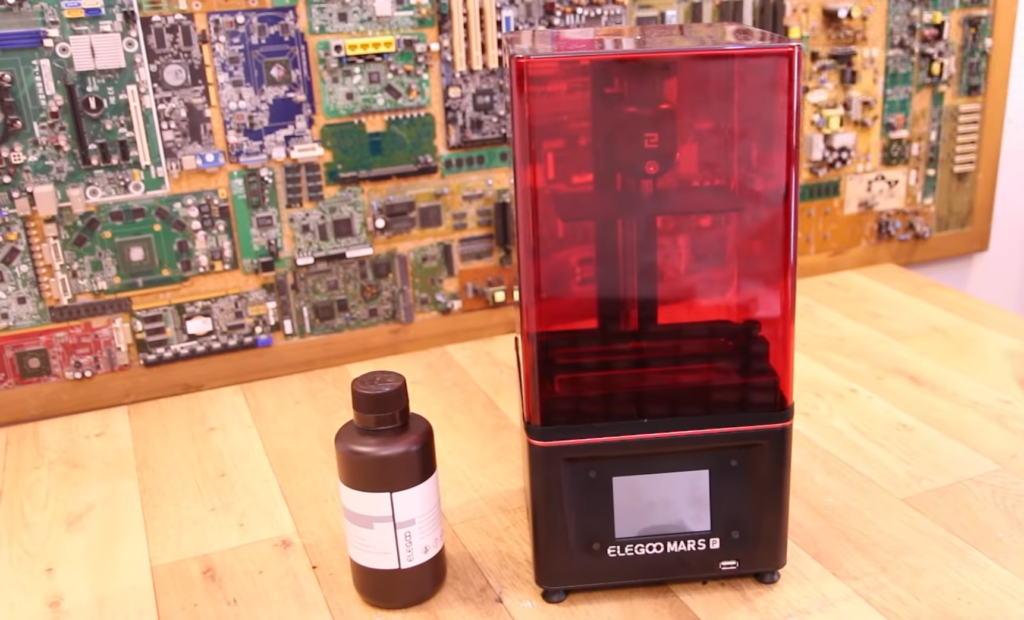
The Elegoo Mars Pro has most of the design elements from the older Mars printer. It has the same small footprint, measuring just 7.87 x 7.87 x 16.14 inches. It takes up only a little space when placed on a desk. It also has the same red UV hood and a black base that sits on four anti-slip feet.
There are only a few notable changes and one of them is the silicone rubber seal that attaches around the edge of the red UV cover. It serves as a gasket, sealing any gaps between the UV lid and the base to prevent the unpleasant resin from leaking and keep out dust.
Another change is the USB port which has been relocated to the front which is a more convenient position that simplifies inserting and removing USB drives from the printer.
On the Elegoo mars, the port was placed on the back of the unit, which was a real hassle since you had to fumble around for the slot to insert or remove the USB drive or switch on/off the machine.
The major improvement, however, is the addition of the carbon filter which is attached to the printer’s frame/base unit. It’s quite an essential and beneficial new feature considering how strong and nauseating resin fumes can be while printing. It absorbs the resin odor during printing and filters them out before they become ventilated throughout the cooling fan.
It really does its job well and together with the rubber seal affixed to the base of the UV lid hood, it drastically cuts down the resin odor. I could hardly detect the resin smell when printing unless when I hovered very close to the printer itself. Many other users on different forums reported that you could easily be near the printer and not even detect the smell, so it’s a major improvement that makes the hazardous process of resin 3D printing refreshing and safer.
Elegoo has also shifted the position of the cooling fan to the bottom of the base unit instead of placing it on the inside like on the Mars model which allowed them to use a slightly larger, slower, and much quieter fan – the stepper motor runs quietly too and the rubber gasket helps to further cut down the noise when printing. You can barely hear the printer running when you are outside the room with the door closed.
However, we saw several complaints that the rubber gasket doesn’t sit well. Different users reported that frequent removals of the UV lid tend to jostle it resulting in it awkwardly settling on top of the printer’s base unit. It also tends to come off easily if you don’t support it when removing the lid.
Another issue is that while the carbon filter does work well, in case the rubber gasket forms an airtight seal, there isn’t any vent to provide sufficient airflow into the lid when closed hence making the filter less effective than it ought to be or even rendering it pretty useless. Fortunately, the gasket sealing isn’t airtight – nonetheless, there should be at least a small vent on the other rear corner of the printer’s body to allow for some airflow.
Overall, the build quality of the Mars Pro is really good. It feels sturdy and well-built, with materials that are of great quality. Most of the parts are made from very solid machined aluminum. The resin vat is even made of aluminum alloy, it’s light but sturdy.
The lead screw system and the linear rail are all metal while the UV lid is a thick acrylic material, so the entire unit is quite durable. It’s not heavy too – it weighs around 16.5 pounds (7.5kg) hence one person can easily carry or move it.
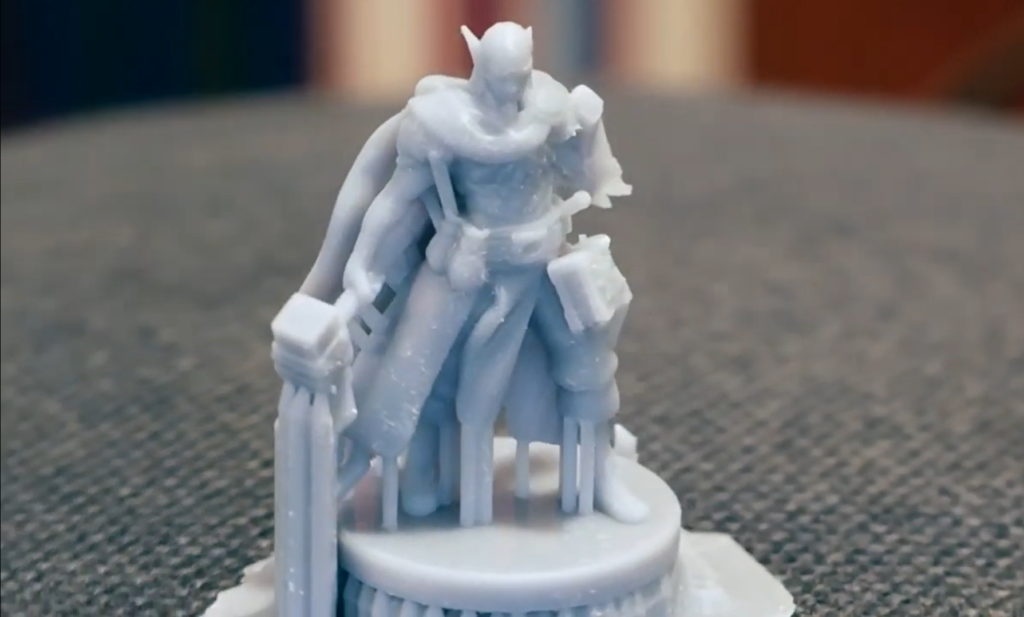
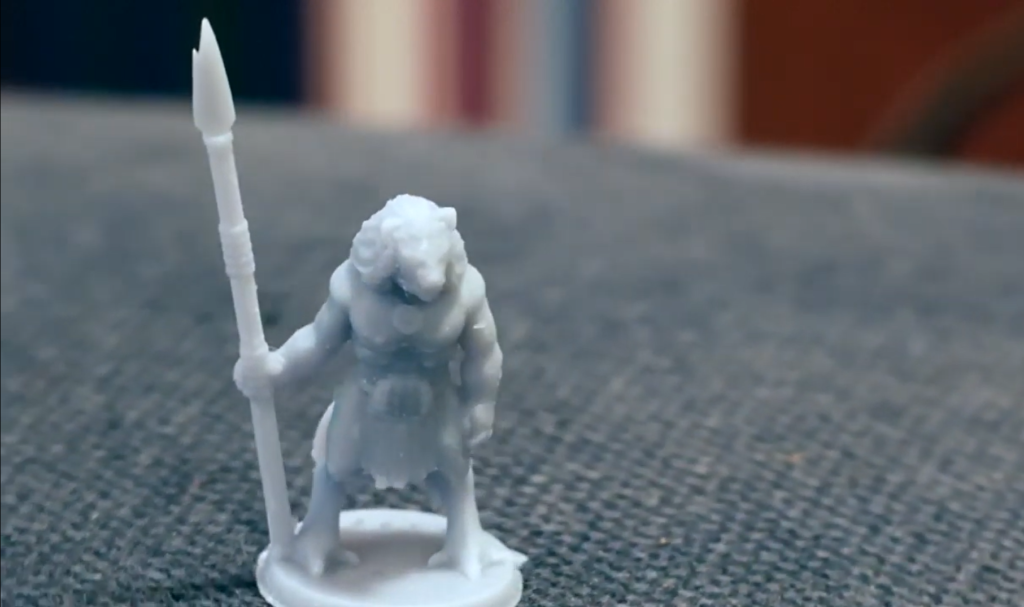
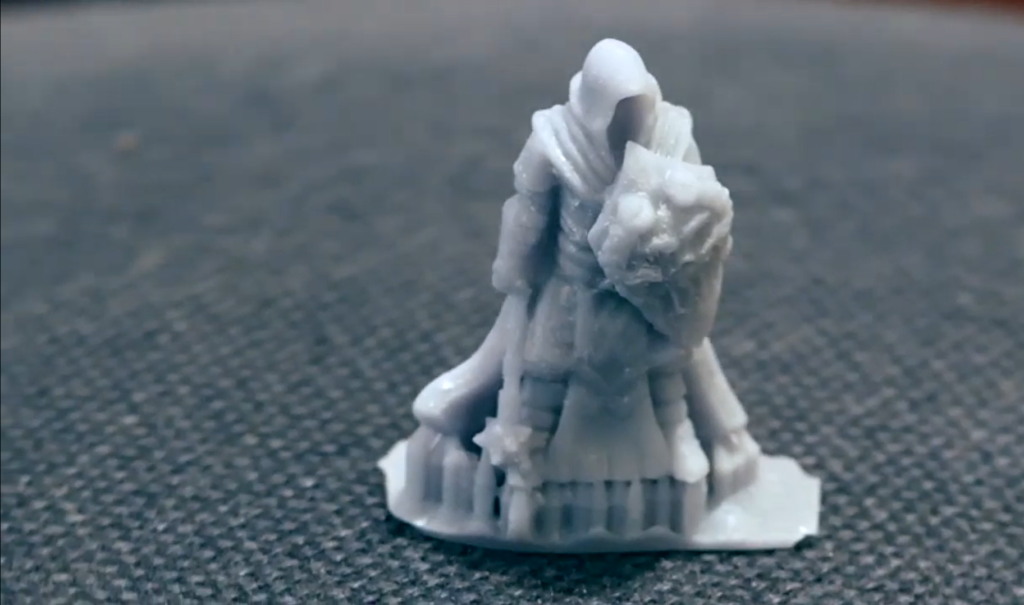
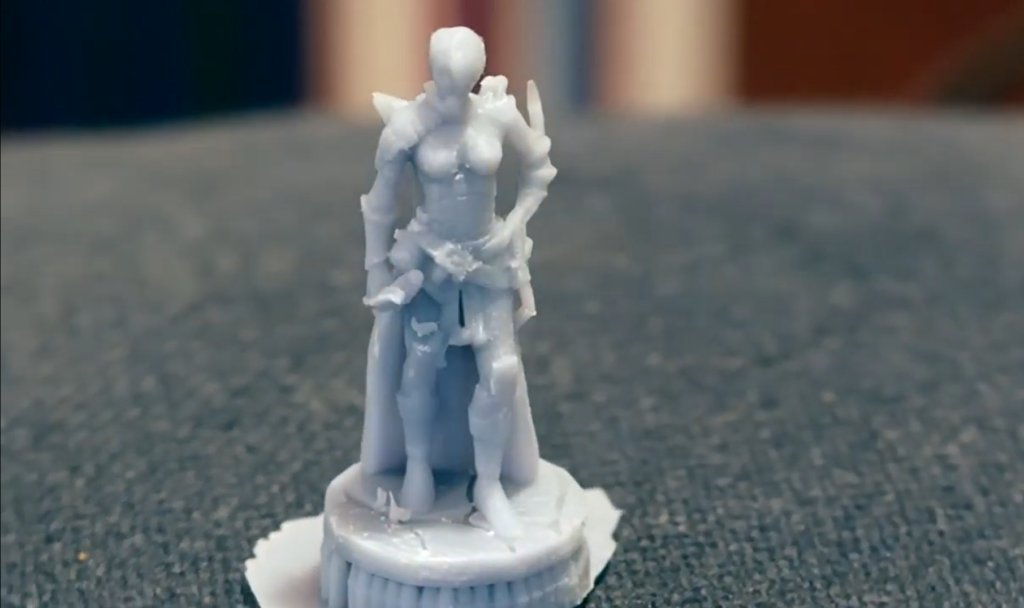
As mentioned earlier, the Mars Pro comes with multiple performance enhancements that significantly improve the quality and accuracy of the prints it produces. The most notable one is the upgrade to the BGW15CA linear guide and fresher stepper motors for the Z-axis.
This new linear guide has a precision of 0.02mm which is the same as that of the original Mars model. The difference is that it’s much steadier, providing a very stable and accurate movement that facilitates more consistency in the print quality throughout the Z-axis – it greatly reduces the layer lines on 3D printed models just as advertised, making their surfaces much smoother.
The light source of the Mars Pro has also been improved to Matrix UV lighting which is made up of 28 50W UV LED lights which is an upgrade from the 40W UV lights of the Mars model. However, they have a wavelength of 405nm which is pretty much what the original Mars model and all other commercial low-cost resin printers that I know work at.
The difference though is that the LEDs are more powerful and provide a much better/increased light uniformity that ensures equal power across the whole build chamber. The outcome of this is that the outer edges of your printed models come out just as precise as the parts that were positioned over the center region of the LCD screen hence you get a more accurate printing size and results.
The masking LCD screen itself is 5.5 inches in size and has a resolution of 2K of 2560 x 1440 pixels, providing an X and Y resolution of 0.047mm/0.00185inches which is equally very good. It’s the same XY axis resolution that the Mars LCD screen offers, so you get the same accurate printing results.
Elegoo has as well equipped the Mars Pro with a new build plate that features a CD grain surface that’s meant to provide higher adhesiveness and increase the overall printing success rate.
All these upgrades have greatly improved the overall performance of the Mars Pro in comparison to its predecessor. The quality of the prints and the level of detail that it produces are amazing – the prints come out accurate, sharp, and solid for the most part.
Our first print on it was the Elegoo Mars test file which came pre-loaded and already sliced for Mars Pro. They were rook chess pieces and they came out looking exquisite. The quality indeed surpassed that of the old Mars model. The lettering was crisp and clear, plus other details like the double helix as well as the spiral staircase that wind down the center of the pieces were well reproduced and easily discernable.
Next up, we tried slicing a couple of prints. Elegoo offers a folder of several popular 3D printable files that are in STL file format. We used the ChiTu Box slicer to prepare some with the Mars Pro pre-set. Their detail was lovely. For instance, a dwarf beard print we did showed fine details of beard hair, flowing weapons, and a textured tunic.
We also tried to print a few parts that I would say fall into the “mechanical category” like the C-mount to an M12 lens adapter. The outside of the adapter was a 1-inch 32TPI thread while on the inside was an M12x0.5 thread – both are pretty fine threads.
Surprisingly, the Mars Pro managed to get the job done. It recreated both threads quite well and they were working. The 1-inch thread did fit well and although the M12 thread was still a bit tight, it nonetheless worked. Printing threads that are this fine is no doubt a tough job, but the Mars Pro managed to pull it off with default slicer settings and without any tweaking.
Repeated prints equally demonstrated uniformity and some level of consistency. The dimensions of most repeated prints varied by mere tens of microns (specifically between prints but not between model and print). Therefore, achieving dimensional accuracy is possible, especially of repeated prints which is essential when you want to print snap-fit replacement parts – this will highly depend, though, on how you set up your model for printing.
It’s possible to experience a slight vertical layer shifting when the build plate isn’t tightly secured which we did when we tried to check the XY precision by creating a keychain of Elegoo logo. That said, both the horizontal and vertical planes printed smoothly – there were no visible grooves or warping.
Having used the Mars and several other MSLA printers, I can say the print performance of the Mars Pro is absolutely amazing. It’s a great option if you are looking to print miniatures, action figures, or small pieces of parts that need to be as accurate as possible. Out of the roughly 30 prints we did, we only had around 5 fails which were mainly due to supports issues that resulted from my ChiTuBox rookie mistakes.
However, there seems to be an almost universal problem with the Mars Pro’s LED array as there were complaints all over Elegoo community pages that its position is very close to the LCD screen which causes grid-like marks and holes on prints. We didn’t notice that in any of our prints but it’s something you want to keep in mind anyway.
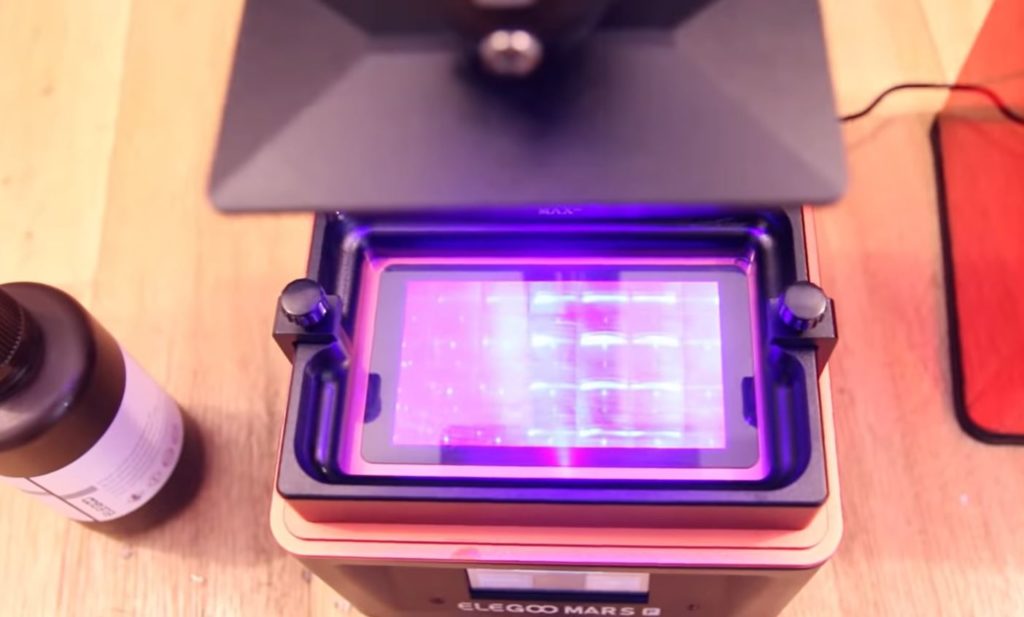
The inclusion of a more powerful LED light system has enabled the Mas Pro to print slightly faster than its predecessor. Elegoo claims that it now takes just 6 seconds to print a regular layer (depending on the resin though) and around 45 seconds for the first layer which is a relatively fast curing speed that puts the Mars Pro in line with several expensive printers from other brands like the Original Prusa SL1.
In our estimate, we found the print speed to be indeed fast as claimed by Elegoo. For instance, the rook chess pieces took around 3 hours to print which was pretty fast considering that we tried printing them on the Creality’s LD-002R and it took about 4 hours to print them.
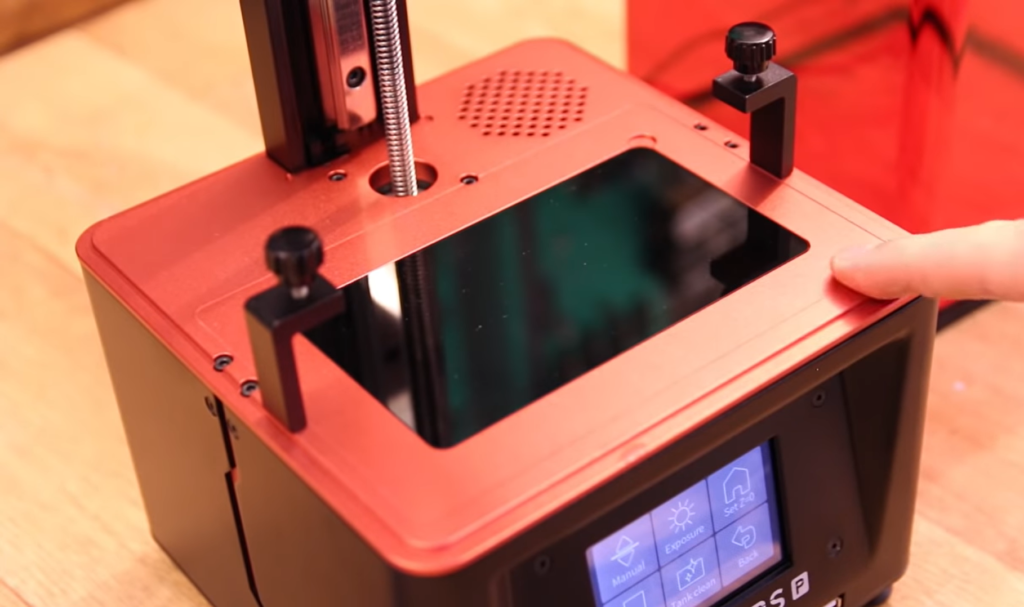
The Mars Pro offers a compact 5.45 x 2.56 x 5.9 inches (120 x 68 x 155 mm) build volume which is similar to what its predecessor offers. So it’s quite tiny and only limits you to printing miniatures and other smaller objects.
Despite that though, the build platform has been greatly improved as it’s now a 0.15mm CD pattern surface which provides a higher success rate. The grip is stronger and much better, allowing prints to stick/adhere more securely to the plate – not one print came unstuck during our time with the Mars Pro.
What’s more, the upgraded plate surface lowers print adhesion to FEP hence the prints come off the build plate easily when finished. On the original Mars model, prints would occasionally tightly stick to the build plate becoming difficult to pry off. Most of them managed to pop off eventually but a few chipped and required a bit of strength to budge or elbow grease to disconnect from the plate.
It was a totally different experience with the Mars Pro. The prints miraculously popped off almost effortlessly – just a light tap from the provided plastic scraper is all that took to gently nudge the prints from the build platform. There were no chipped prints whatsoever.
Some users did however report that their prints sometimes didn’t stick to the print bed but instead, they would stick to the FEP or the bottom of the vat. We didn’t experience that throughout the time we used the Mars Pro. The resin would adhere to the plate very well while printing and then come easily off when done, so it’s not really a widespread problem.
Elegoo has also included plastic support alongside this printer. I found it to be a really useful addition as it helps angle/slope the top side of the build plate which is an important detail because it allows the resin to drip off better when a print is finished hence resulting in a much less messy experience. We’ve had a printer where the plate is flat on top and each time a print is finished, it would carry some resin up with it which would drip all over the place.
The other advantage of this new build platform of the Mars Pro is that it doesn’t need to be re-leveled often. The set screws have been upgraded to anti-slip hexagon socket screws which are larger and more resilient hence making them much stable and able to hold the plate in place perfectly once it’s leveled.
The Mars Pro works with any resin that uses the 405nm UV light to cure. A sample resin is not included in the package, so you’ll have to get at least a bottle of UV-curable resin separately. Elegoo’s resins are readily available, of good quality, and reasonably priced.
We tried both opaque and translucent resins from the company and all worked well – we had no problem achieving precise results. The printer basically supports the same photopolymer resins as its predecessor. It can work with resins from other brands too.
We tried the Siraya Tech Fast resin which we used to print a sword. It’s totally a different non-Elegoo brand resin but it worked great, although only after some tweaking to figure out the ideal settings to make it work right.
Generally, there are many different types and colors of resin out there, so you have to ensure you do your research well because some will work with the printer, while others may require a lot of extra tweaking to tune before they work.
One thing we liked is that the resin vat of the Mars Pro has a new style that features stepped walls which allows it to hold more resin in basically the same footprint as that of the Mars thick-walled vat. This means you can print a bit longer without a refill.
Like its predecessor, the Mars Pro is very easy to use. It comes with the same 3.5-inch color touchscreen with a simple menu that allows you to home the machine, set the Z-axis zero position, enable exposure, print, and so on. There are no fancy features such as tilting bed, resin level sensors, or Wi-Fi connectivity – it’s just the same basic settings found on the original Mars printer.
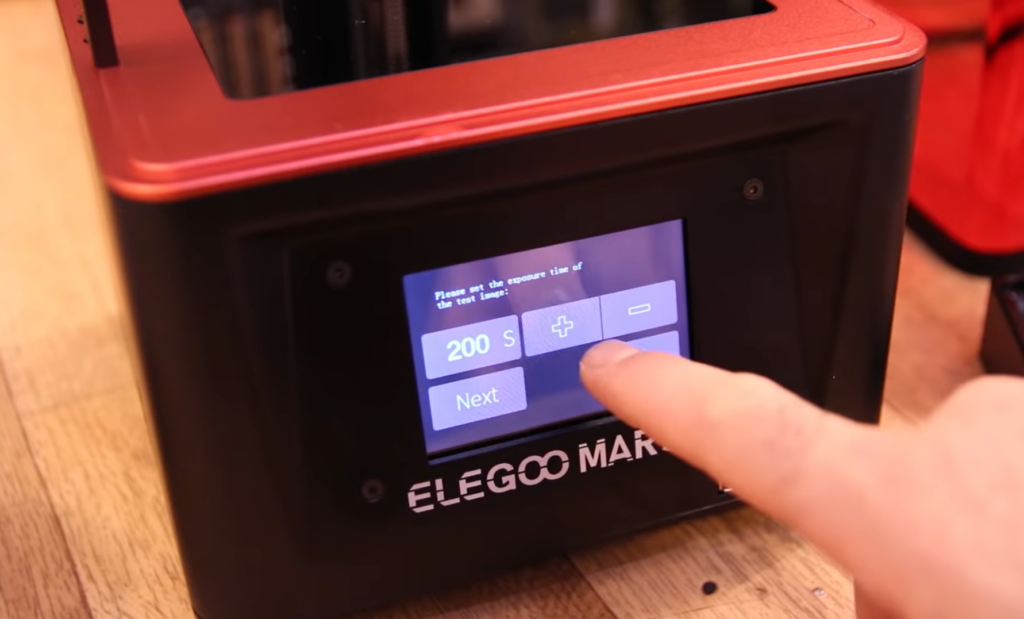
To print a model you just drop your .ctb sliced file onto your flash drive and then directly plug it to the Mars Pro, tweak the settings, and let the printer do its work. It’s very simple to use, even for beginners, plus the touchscreen is very responsive, there was no lagging whatsoever.
Moving the USB port from the back to the front, just by the LCD display is one of the improvements that I appreciated as it saved me the hassle of reaching behind the unit every time I wanted to insert or remove the USB drive which was the case with the earlier Mars model.
On the software side, the Mars Pro works with ChiTuBox which is free slicing software that’s purposely designed for resin printers such as the Mars line from Elegoo. It’s a solid, robust slicing program that’s fairly easy to use once you get to learn and understand it.
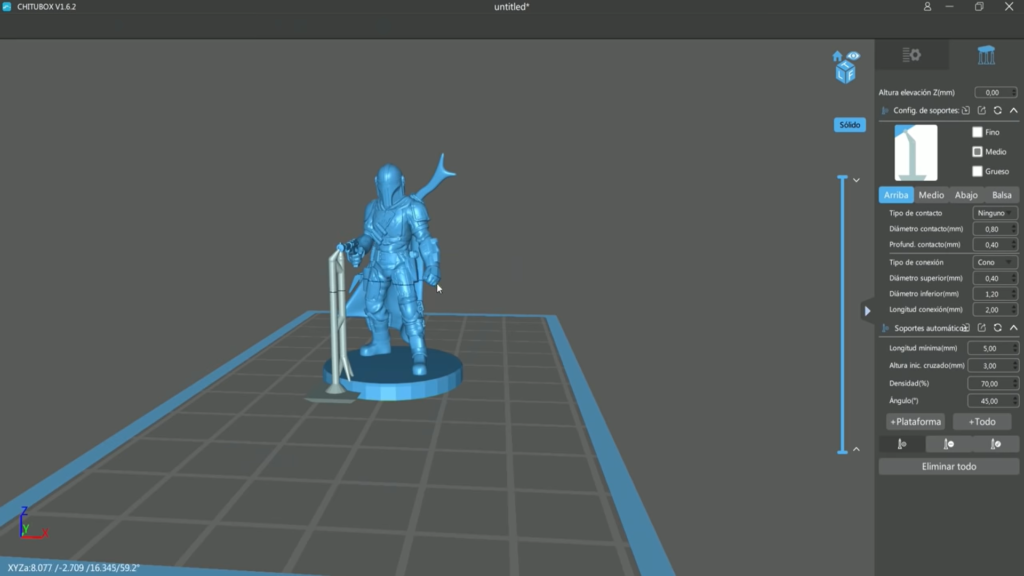
All the material settings are done in the slicer including lift speeds and UV times. The software has printer profiles as well as some common resin profiles, so you could basically tweak settings from either a pre-built profile or just start from scratch. You can redo and undo changes, and even drag models around once you’ve added support structures (all without destructively undoing your work).
Best of all, Elegoo has refined the compatibility between ChiTu Box and the Mars Pro such that the printer is now compatible with the exclusive CTB file extension which is a new and light sliced file format that’s about 20 times smaller than the previous standard sliced files like .cbddlp format that the Mars supports.
It generally reduces the file size by roughly 90% compared to the .cbddlp which significantly increases the overall printing success rate, especially when printing bigger models.
The ChiTu Box software is compatible with Mac, Linux, and Windows operating systems so you just install it on your computer and use it to prepare your 3D print and put the .ctb file on a USB stick for printing. The printer is a stand-alone machine – it only prints files off a flash drive. It’s not Wi-Fi enabled and does not support direct cabling from the computer.
The ChiTu Box itself receives pretty frequent updates and with the new firmware update of the Mars Pro, you can expect to access new and improved functionality and features. Besides that, there’s a large functional and helpful Elegoo online community, so you’ll be able to find forums where you can get help and accurate settings for ChiTu Box and the printer itself.
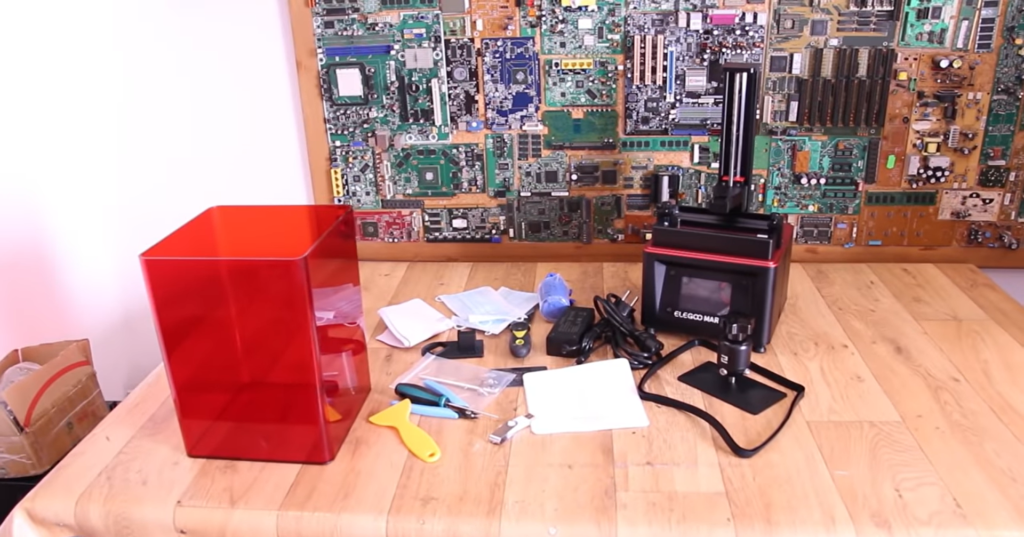
The Elegoo Mars Pro came in a cardboard box and when we opened it we found two parts, the printer itself and the toolbox which were well packed in the box. The machine had the acrylic UV case on and when you remove it, you find even more protection inside that ensures the printing plate and other critical parts remained put during shipping.
There’s little to do in terms of assembly as the machine arrives almost fully assembled and ready to go right out of the box. The only thing you need to do is attach the rubber seal around the base of the UV hood, screw the build plate into the vertical rail (Z-axis arm), level it, load the resin, connect the printer to power, and you are good to go.
There’s an instruction booklet that contains setup information and safety warnings which is definitely worth reading through. The bed leveling process is similar to other resin printers, so it isn’t challenging. Moreover, the fact that the set screws were now large anti-slip hexagon socket screws made leveling the build plate even easier and long-lasting.
You simply loosen up the set screws, drop the build plate down to the printer’s base, and use a piece of paper to help set the correct distance from the build plate to the base. From there, you just tighten the set screws and then home the plate and zero it out. It’s a process that takes less than five minutes.
Unfortunately, though, the provided instruction manual has an error as it states that the first step is to put the Z-axis position to Zero yet the correct first step is to set the Z-axis to Home which you do by pressing the Home button on the menu on the touchscreen – the text itself is false but the images show the correct set-up steps.
Overall, the printer was simple to set up and calibrate, plus Elegoo has included nearly everything you need to get started inside the toolbox. You get a face mask, scraper, screwdriver, some pliers, and a rubber seal for the UV hood. Also included are the power cord, power adapter, and plastic support for angling the print bed.
You as well get latex gloves which you should always wear when pouring resin, a small plastic cup that you use to pour out resin from the vat, and some paper filters for straining out the resin. A USB thumb drive is provided too and it’s preloaded with test prints. The only thing not included is a sample bottle of resin which you have to purchase separately.
As with all resin printers, cleaning up after a print is usually the worst part, especially after a failed print as you need to clean up a smelly and sticky mess that’s poisonous. That said though, cleaning the Mars Pro was relatively easy as most of the prints came off easily and I had only a few failed prints.
The resin vat is simple to remove. You just unscrew two knobs on the inside, take it out and strain out the resin using the provided paper filter to remove cured resin bits from the failed print. From there, you can clean it by wiping down the tank and tray using a microfiber cloth, and then spraying them with a 95%+ alcohol-based solution.
Chunks of a print can cling to the bottom of the tank and you’ll need to remove them by scraping gently using the provided scraper while it’s above the screen to avoid damaging the FEP film – it’s thin and if you’re rough you are likely to scratch it and wreck it. It’s cheap and relatively easy to replace though.
The printing plate is removable too and can be cleaned easily by an alcohol-based glass cleaner or replaced if its performance degrades over time. The part that appears challenging to clean or maintain is the built-in carbon filter. It has only a 6-month lifespan if you use the printer regularly yet it doesn’t seem to be easily replaceable because I couldn’t see any easy way of accessing it from a quick disassembly.
Elegoo provides no guidance either on how to replace it and we couldn’t also find where you can buy the replacement filter, so once it gets used up then you’re are essentially left with a printer that actively blows unfiltered resin fumes into your room. It’s the same case with the fan assembly – there’s no easy way to disassemble the unit to access it and clean it.